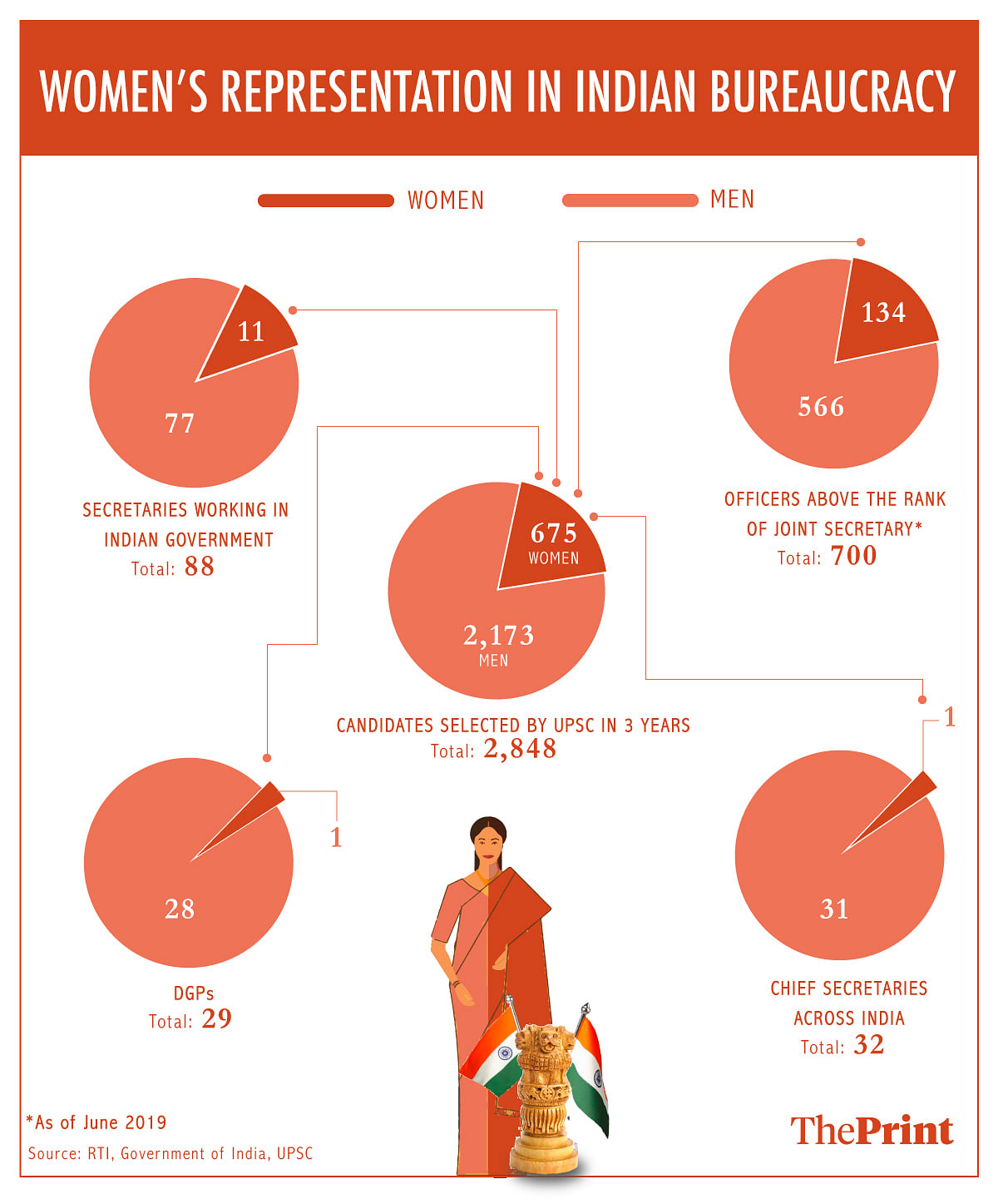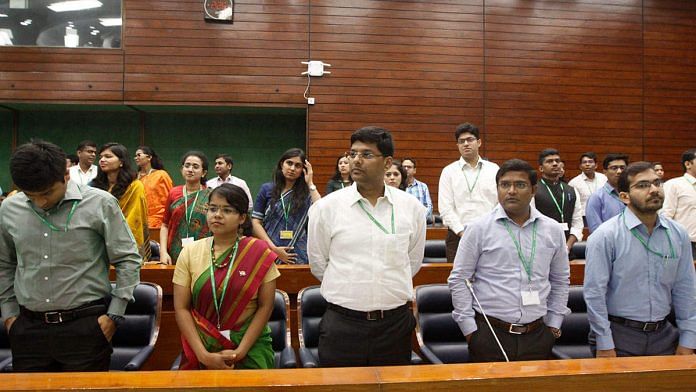New Delhi: Until Monday, 14 October, the number of women secretaries working in the Government of India stood at 12, or just under 13 per cent. This abysmally low figure came down further Tuesday when the Narendra Modi government repatriated School Education Secretary Rina Ray to her parent cadre.
Ray is a 1984-batch IAS officer from the AGMUT (Arunachal Pradesh, Goa, Mizoram, Union Territories) cadre. She is due to retire in 2021.
Ray, whose unceremonious ouster from the Ministry of Human Resource Development comes following alleged differences over policy issues with the PMO, was one of the few women IAS officers to make it to the top echelons of bureaucracy.
88 secretary-rank officers in central govt — only 11 are women
Consider this: Of the 88 secretary-rank officers in the central government, only 11 are women. While a few like Preeti Sudan, Secretary, Health, and Vijay Thakur Singh, Secretary (East), Ministry of External Affairs (MEA), hold important portfolios, most other women officers are posted in departments and ministries such as fisheries, official languages, disability or youth affairs.
According to government data, of the 700 officers working in the central government at the joint secretary level and above, only 134 — or 19.14 per cent — were women as of June 2019.
The only woman lateral entrant selected by the government to join as a joint secretary has declined the offer, ThePrint has learnt.
At the state level too, the numbers are not encouraging. Of the 32 chief secretaries across states and union territories, only one — Haryana’s Keshni Anand Arora — is a woman. Among the directors general of police too, Karnataka’s Neelamani Raju is the only woman IPS officer.
Also read: In IAS training academy, women civil servants are seen by male colleagues as husband-hunters

Women’s participation in the workforce has dropped across sectors in India, said Lekha Chakraborty, professor at the National Institute of Public Policy and Finance. But, she added, the participation of women in bureaucracy was “abysmally low”.
Chakraborty also said there are some factors peculiar to the civil services that made it harder for women to climb up the ladder.
“In the bureaucracy, attributes like self-promotion and the ability to form informal networks are very important. That’s where efficient women lose out,” she said.
“There may be as many efficient women out there as there are men, but the journey of an efficient man and an efficient woman would still be very different.”
While there is no reservation for women in the civil services, it could be a solution to ensure that at least more efficient women enter the bureaucracy in the first place, she said,
Not many women make it to the top
“The reason you see fewer women officers rising to the top is because the intake ratio is skewed,” said Aruna Sharma, an IAS officer of the 1982 batch who retired as the Union steel secretary last year. “In my batch, for example, there were just 14 women out of a total of 140 IAS officers.”
While Sharma insisted that there is no hostility that women face in terms of postings and promotions in the government, others disagree.
Rina Mitra, a senior IPS officer, who was in the race for the post of the director of the Central Bureau of Investigation (CBI), was sidelined allegedly over a technicality. Soon after, she wrote about the “biases” that work against women in bureaucracy.
“I did qualify on all parameters to be considered for the selection to head the premier investigation body of the country…I was indeed the senior-most officer fulfilling all the four essential criteria including experience in CBI and anti-corruption… However, an easily avoidable delay of just one day in the selection process ensured that I was bumped out of the race and no longer in contention.”
T.R. Raghunandan, another retired IAS officer, said Mitra’s experience is far from being an exception. “There is a strong selection bias against women for senior postings,” he said.
“Throughout my career, for instance, I saw that a lot of women were sidelined for the post of the cabinet secretary when they were adequately qualified.”
In independent India, no woman has ever risen to the rank of cabinet secretary — the top-most executive official and head of civil services in the country.
“With this government, one would think things would be better because they have appointed women as ministers in ministries like defence, MEA, finance, etc… But it seems that they are breaking the convention politically, but not administratively,” Raghunandan said.
Sharma’s argument that the reason behind fewer women rising to the top is the skewed intake ratio is corroborated by the available numbers.
Over the years, while the percentage of women being selected by the UPSC has gone up, it has averaged to just 24 per cent even in the last three years.
The latest batch of 759 civil servants recruited by the UPSC this year had just 182 women. In the 2017 batch, when 990 civil servants were recruited, there were just 240 women. In 2016, while a total of 1,099 candidates were recruited, only 253 were women.
Also read: How IAS, IPS, IRS and other associations have lost their voice under Modi govt
Only 3 women for every 10 men opt for UPSC
“It is needless to say that there is no bias in selection when it comes to the UPSC,” said a senior official of the commission, who did not wish to be named. “But we have seen over time that fewer women in comparison to men opt for the civil services…It is unfortunate, but for every 10 men appearing for the exam, you would have three women appearing,” the official added.
Over the decades, sexist caveats like women should leave the civil services if they were to get married have been done away with, but it is the same set of biases that precludes larger number of women preferring science and technology as a career option, said Raghunandan.
“It seems that it’s just the same biases at play here, but the government could remedy it by proactively ensuring that women get promoted,” he added. “That is something nobody is willing to do.”
A young woman IAS officer, who did not want to be named, said civil services were not a popular career option for women even now.
“We live in the kind of society where girls are being educated by their parents, but when it comes to jobs they are conditioned to opt for careers that allow them flexibility so that they can ‘balance’ work and families…It is not an expectation that the society has from men at all.”
Also read: Why civil services exams in some states have had higher cut-offs for SC/ST & OBC applicants







The entire responsibility of the state of IAS,IPS,IFS and IRS soley rests with the Babus themselves for good and bad. For feathering their nests, a lot of them have exploited the politicians to the hilt. Some of the breed has connived with them, bent backwards to accommodate them, bullied the stupid ones and refrained from giving their best to the country. It is extremely unfortunate that people selected and trained after a rigorous process as the cream from the society for their intelligence and capabilities could not be screened for integrity. They are the ones entrusted with the job of guiding the politicians who come and go. Just as there are outstanding people who made the service proud with unmatched contributions, there have also been some infamous people who provided the politicians with a deadly cocktail of intelligence and capabilities with complete lack of honesty and integrity. It was and is the silence of the a large number in arresting the rot that keeps clan wanting in many areas instead of making the country proud of this selected cream.
Maharashtra, a progressive state, has never had a lady Chief Secretary. India – can one say it is a progressive country, as well – has never had a lady Cabinet Secretary. Hopefully, both situations will be remedied, sooner rather than later.